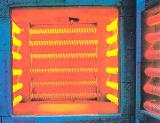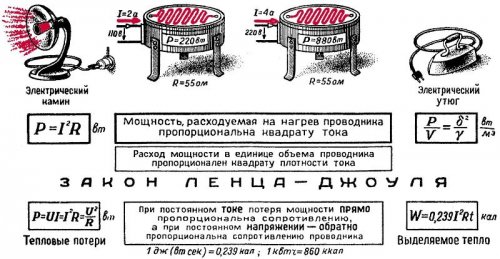The Joule-Lenz law
 Overcoming the resistance of the wire, the electric current does work, during which heat is generated in the wire. Free electrons in their movement collide with atoms and molecules, and during these collisions the mechanical energy of the moving electrons is converted into thermal energy.
Overcoming the resistance of the wire, the electric current does work, during which heat is generated in the wire. Free electrons in their movement collide with atoms and molecules, and during these collisions the mechanical energy of the moving electrons is converted into thermal energy.
The dependence of thermal energy on the strength of the current in the conductor is determined by the Joule-Lenz law. When an electric current flows through a wire, the amount of heat generated by the current in the wire is directly proportional to the strength of the current taken to the second power, the magnitude of the resistance of the wire, and the duration of the current.
If the amount of heat is denoted by the letter Q, the current strength in a is A, resistance in ohms — R and time in seconds — t, then mathematically the Joule-Lenz law can be represented as follows:
Q = aI2Rt
NSfor a = 1, the amount of heat Q will be joules. NSpa a = 0.24 the amount of heat Q is obtained in small calories. The factor 0.24 appears in the formula because a current of 1 A in a wire of resistance 1 ohm for 1 second. gives off 0.24 small calories of heat. A small calorie serves as a unit for measuring the amount of heat. A small calorie is equal to the amount of heat needed to heat 1 g of water by 1 °C.
This law was independently discovered in 1840 by the English physicist James Joule and the Russian physicist Emily Kristianovich Lenz. This physical law determines the amount of heat Q released in a conductor when an electric current passes through it.
So heat is always generated in a conductor when current flows through it. However, excessive heating of wires and electrical devices should not be allowed, as this will damage them. Overheating is especially dangerous when short circuit wires, that is, in the electrical connection of wires supplying electrical energy to the consumer.
In the event of a short circuit, the resistance of the wires remaining under the current is usually negligible, the current therefore reaches a large force and heat is released in such an amount that it causes an accident. To protect against short circuits and overheating, the circuit includes fuses… They are small pieces of thin wire or plate that burn as soon as the current reaches a certain value. The choice of fuses is made depending on the cross-sectional area of the wires.

